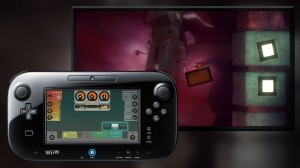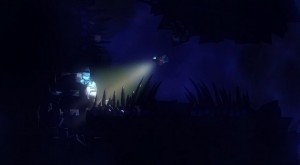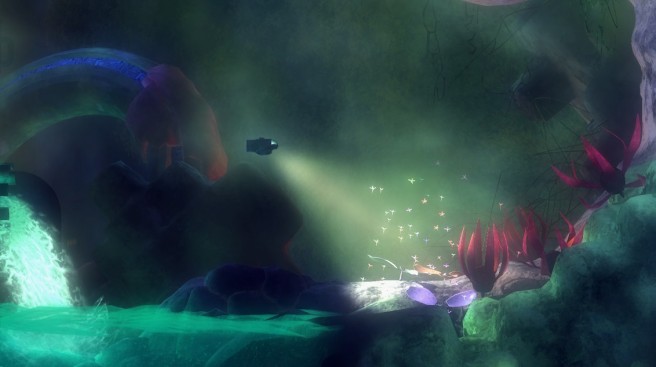[Review] Affordable Space Adventures
System: Wii U (eShop)
Release: April 9, 2015
Developer: KnapNok Games & Nifflas Games
Publisher: KnapNok Games
Author: Patrick
I have to confess, I’m not a fan of the Wii U’s GamePad. For a peripheral that comes with every console, very few games have justified using this massive tablet over a more conventional controller. Sure, off-TV play is great and some of the early releases like ZombiU and Game & Wario provided a nice taste of what the controller was capable of, but the GamePad as a whole smacks of wasted potential. Thankfully, next week sees the eShop release of Affordable Space Adventures, a planet-exploring puzzle game that promises to put the GamePad to good use. If any studio can use this pricey controller effectively it’s developer KnapNok Games, who previously published Spin the Bottle: Bumpie’s Party, one of the few titles that did use the GamePad in interesting ways to create an quirky co-operative experience. Joining them in this collaboration is game designer Nicklas “Nifflas” Nygren, who has produced several moody games based around exploration including Knytt Underground. These two European studios both have very different styles, so how well do they mesh and deliver on their promise that the game “truly utilizes the potential of the Wii U”?
Affordable Space Adventures sees players taking off in a Small Craft for what the UExplore company promises to be a relaxing, side-scrolling journey through the planet of Spectaculon. It’s not hard to see how the planet got its name; the voyage across the planet covers an imaginative range of environments from vast canyons to snowfields. Each location looks fantastic and it’s partially due to the lack of any Heads Up Display obscuring the action onscreen. Instead, there’s a “Heads Down Display” on the GamePad, which is essential for maneuvering the Small Craft and serves as the game’s big hook.

While the analog sticks handle moving the ship and scanning objects, just about every other function is located on this lower screen. It’s easy to control the output of the ship’s thrusters with a quick tap of the screen, but not so simple once the lower screen ends up covered in icons. Though the journey starts out straightforward, the game gradually introduces new puzzle-solving functions like controlling the ship’s mass to push larger objects or enabling stabilizers to get through tight spaces. Quickly manipulating these functions is essential once the difficulty ramps up, so thankfully some of the GamePad’s buttons serve as shortcuts. Eventually there’s a second engine type to switch between, then the ability to manipulate the ship’s temperature, different landing gear and more. Sounds overwhelming? It absolutely is, but the progression of introducing each new function, having the player understand what it does and then exploit it by using it to solve puzzles is smooth and satisfying. There’s nothing quite like the feeling of having full mastery over the whole ship and its massive range of devices.
Even if these complex controls end up being a bit overwhelming, the jobs onboard the craft can be split between other players with Wii remotes or Pro Controllers. Of course, this style of play comes with its own problems. When one player is in charge of moving the Small Craft while the other controls its functions, communication and co-operation is essential. This results in a local multiplayer mode that’s frequently chaotic but quite memorable.

The surface of Spectaculon is covered in dangerous “artifacts” that stand in the Small Craft’s way. These obstacles can detect the ship’s heat, sound and electrical output, letting loose with a blast of electromagnetic energy or similarly deadly force if any of these three parameters trips its sensor. After most of the ship’s functions have been introduced, the bulk of the puzzle solving involves sneaking past these artifacts undetected. Scanning artifacts reveals their “line of sight” so there’s never any ambiguity over whether they can detect the ship; the real challenge comes from figuring which of the ships functions need to be disabled to safely pass them. Some of the solutions are straightforward, like closing the ship’s ventilation to prevent heat from escaping, but others require thinking outside of the box and knowing exactly how much noise, heat and electricity each utility generates (hope you paid attention to the loading screens!). All of this information is shown on the GamePad, making it easy to track the output levels even if you need to take your eyes away from the main screen.
The puzzles in Affordable Space Adventures are generally very well designed; though there’s typically only ever one solution, the game rewards thinking creatively. Though it requires steady piloting and aiming, Affordable Space Adventures most definitely isn’t an action game. Rushing is a good way to get your ship wrecked and it’s usually best to take your time in coming up with a solution. That said, there are plenty of stressful moments where players have to deal with unexpected incidents like the ship suddenly overheating or being grabbed strange tentacles. The later parts of the game in particular thrive on making players uncomfortable by suddenly removing essential functions you’ve relied on for past puzzles.

Getting past some obstacles requires a bit of trial and error, but the checkpoints are quite generous. Even after a “critical existence failure”, your ship takes very little time to recover, usually close to whatever artifact caused its destruction. While the checkpoints are very frequent, the save points don’t seem to make a lot of sense. I was under the assumption that the game saved after every level, but there were several occasions where I’d quit the game, return and find that I’d lost a chunk of progress. Even if the save points aren’t at the end of each level, it’d be nice to have some indication of when the game is being saved. Ultimately the levels are so short that it’s just a minor annoyance, though, and the kind of thing that can be patched in (if it isn’t just my imagination).
Spectaculon has a great atmosphere and it’s thanks to the detailed environments and the use of lighting. Often the only source of light comes from the Small Craft’s scanner, which creates suspense since there’s no way to know what’s lurking in the shadows. It’s all very creepy in a G-rated kind of way. Also unnerving is the game’s soundtrack, which is usually quite low-key but that just makes it even more frightening when an artifact loudly activates. As nice as the locations look, they are pretty empty and while this adds to the feeling of isolation I wish they did a better job of showing why the planet was abandoned and where all these deadly technology came from. I’ll certainly remember the game for the puzzles, not the environments.

But then the narrative isn’t really the focus of Affordable Space Adventures. Aside from a few brief cutscenes between levels there isn’t a whole lot of story to deal with and it’s probably for the best. Nifflas’ gloomy environments and the quirky humour of KnapNok Games don’t quite mix. That might have been the intention, but the odd juxtaposition between exploring desolate landscapes and the story of UExplore’s corporate incompetence didn’t do much for me.
The ending is also a bit abrupt, even if has some neat Miiverse integration. It took me about five hours to clear all the levels and fully explore Spectaculon, which felt a bit on the short side. To the game’s credit, the whole experience is well paced and never really runs out of new mechanics to mess around with, but the price tag is fairly high for an eShop game. Ultimately whether or not these space adventures are actually “affordable” is up to the player. For a game based around exploration, the progression is disappointingly linear and it could have used some sort of incentive for players to replay the game and explore the levels more thoroughly. That said, the gameplay itself is so unique that I’ll likely revisit it along with a couple of co-pilots.

Affordable Space Adventures isn’t the best puzzle game on the Wii U, but it’s an intriguing experiment that’s worth checking out. It lacks the seemingly endless content of Pushmo World, the story of The Swapper and the production values of Captain Toad, but what it does have is a brilliant control scheme that makes use of the GamePad in creative ways. Though the journey is brief and linear, it’s packed with brilliant puzzles that push players to think creatively in figuring out how to best use the range of tools at their disposal. If you’re after a showcase for the Wii U GamePad, this is it.
